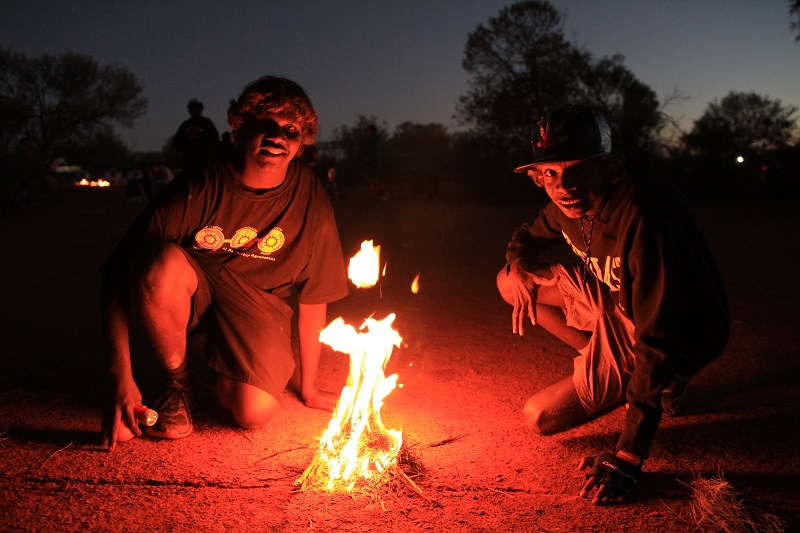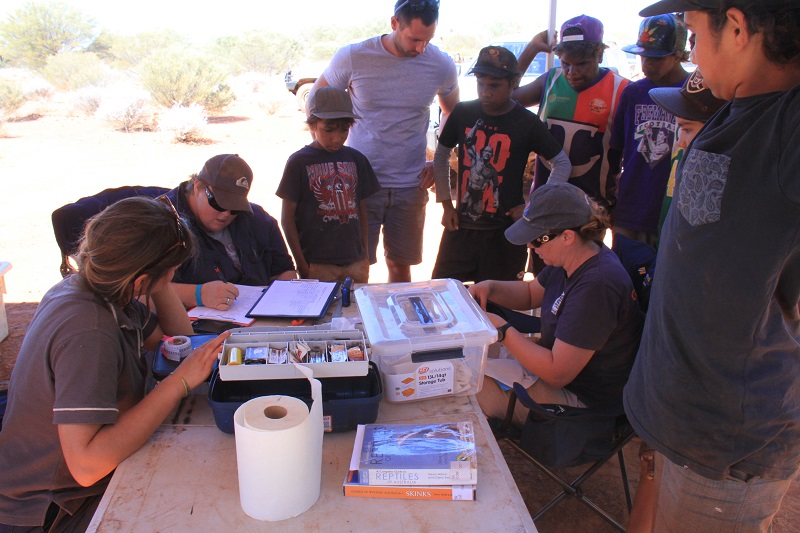Our Science Pathways program took students to the edge of the Gibson Desert in Western Australia to attend a biological survey, blending Traditional Ecological Knowledge with Western science.

Indigenous students by a camp fire during a Science Pathways trip to the edge of the Gibson Desert
Stuart and Romano – winners of the fire lighting competition.
Getting 52 people in eleven four-wheel drives to the edge of the Gibson Desert in Western Australia for a four day school trip to conduct a wildlife survey with scientists and Aboriginal Elders was a bit of a logistical nightmare, but we made it in the end!
Twenty students from Wiluna and Leonora Schools participated in the Science Pathways program at Matuwa Kurrara Kurrara Indigenous Protected Area (IPA). The Science Pathways program builds on the strengths of Aboriginal desert communities by using a two-way approach to align traditional ecological knowledge with Western science.
“The amount of information that the kids found out; talking with the old ladies, language and science. They didn’t even know they were doing school work,” said Fifi Harris, an Aboriginal and Islander Education Officer who works at Leonora High School.
Students learned tracking skills from Wiluna Rangers and applied these in the collection of data for a project looking at the abundance of native marsupials and feral animals in different areas of the Indigenous Protected Area. They found populations of the threatened Ninu (Bilby) with evidence of burrows, tracks and scats, all confirmed by camera trap pictures.

Scientists and park rangers work with Indigenous students and Elders to track wildlife in Matuwa Kurrara Kurrara Indigenous Protected Area (IPA) during Science Pathways school trip in Western Australia.
Scientists and park rangers work with Indigenous students and Elders to track wildlife in Matuwa Kurrara Kurrara Indigenous Protected Area (IPA).
In the first ever biological survey held on Kurrara Kurrara, students learned from Department for Parks and Wildlife scientists about the special adaptations of desert marsupials and reptiles. The also learned how to weigh, measure and identify different species including the Dunnart, Spinifex mouse and the spiky Gidgee Skink.
“We learnt that you measure a lizard from the nose to the bum hole!” said Aeishah Muir, a Year 6 student.
Traditional Owners took everyone to Nyimbin (Sydney Head) and told stories of Pujiman days in Martu language.
“We learnt about the land and how you look after it. If you look after the land, the land looks after you,” said Romarno Jackson, a high school student.
You can find out more about our programs here.
Science Pathways for Indigenous Communities is one element of the Indigenous STEM Education Project which is delivered by CSIRO and funded by the BHP Billiton Foundation. In Western Australia, Science Pathways operates in six Western Desert communities to facilitate schools, Traditional Owners and scientists to develop a Two-way science curriculum based around Learning on Country activities. Science Pathways aims to increase the engagement of Indigenous students with science education and careers.

